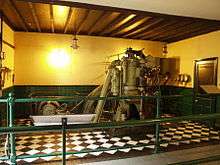History of Sulzer diesel engines

This article covers the History of Sulzer diesel engines from 1898 to 1997. Sulzer Brothers foundry was established in Winterthur, Switzerland, in 1834 by Johann Jakob Sulzer-Neuffert and his two sons, Johann Jakob and Salomon. Products included cast iron, firefighting pumps and textile machinery. Co-operation with Rudolf Diesel led to the construction of the first Sulzer diesel engine in 1898. In 2015, the Sulzer company lives on but it no longer manufactures diesel engines, having sold the diesel engine business to Wärtsilä in 1997. [1][2]
Overview
Sulzer built diesel engines for stationary, road, rail and marine use. The engine types usually comprise a number, then some letters, then another number. For example, 6LDA28 indicates a six-cylinder engine in the "LDA" series with a 28cm cylinder bore.
Stationary

Road
In 1937, Sulzer introduced an opposed piston two-stroke diesel engine for road use. This was similar to the Commer TS3 but had a piston-type blower instead of a Roots blower. It was made in two sizes: 69mm bore x 101.6mm stroke or 89mm bore by 120mm stroke. The smaller version had two cylinders, produced 35 hp, and was intended for tractors. The larger version was available with two, three or four cylinders and was intended for trucks.[3]
Rail
These are examples, not a full list.
Type LDA28
- Example applications, 6 cylinders
- British Rail Class 24
- British Rail Class 25
- British Rail Class 26
- British Rail Class 27
- CIE 113 Class
- Example applications, 8 cylinders
- Example applications, 12 cylinders
Type LVA24
- Example applications, 12 cylinders
- Example applications, 16 cylinders
Type LV31
- Example applications, 8 cylinders
Marine
These are examples, not a full list.
Type RTA76
- Example applications, 5 cylinders
- Example applications, 8 cylinders
Type TADS56
- Example applications, 5 cylinders
Licences
Licences to build diesel engines to Sulzer's design were granted to Vickers-Armstrongs in the United Kingdom, to Busch-Sulzer in the United States, to Reșița works in Romania and to H. Cegielski – Poznań in Poland.
References
- ↑ http://www.sulzer.com/en/About-us/History
- ↑ http://www.derbysulzers.com/sulzerengine.html
- ↑ Smith, Donald H. (1959). The Modern Diesel (13th ed.). London: Iliffe & Sons. pp. 192–193.